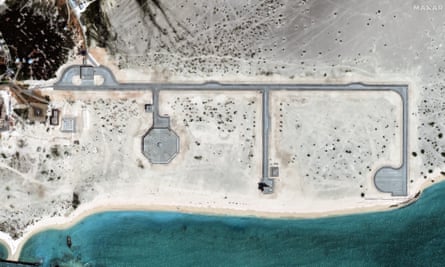The Chinese military is constructing a new counter-stealth radar system on a disputed reef in the South China Sea that would significantly expand its surveillance capabilities in the region, satellite imagery suggests.
Analysis by Chatham House suggests China is upgrading its outpost on Triton Island, on the south-west corner of the Paracel archipelago, building what may be a launching point for an anti-ship missile battery, as well as the sophisticated radar system.
“By constraining the US ability to operate stealth aircraft, and threaten stealth aircraft, these capabilities in the South China Sea send a powerful signal to US allies and partners in the region that the US advanced technologies may not be able to stand up to the PLA (People’s Liberation Army),” said Michael Dahm, a senior resident fellow at the Mitchell Institute for Aerospace Studies.
Similar counter-stealth radars, known as SIAR, or synthetic impulse and aperture radar, have been built to the south, on Subi reef in the Spratly Island chain, and on Hainan Island, to the north. The construction on Triton will close a gap in its coverage. “Triton Island is another brick in the wall,” said Dahm, who added China has for three decades been building technologies to protect against the advanced stealth capabilities of the US.
Triton, a reef about 120ha in size, lies in the farthest south-west corner of the Paracels, an archipelago that has been controlled by China since a violent conflict with Vietnam in 1974. It is also claimed by Taiwan and Vietnam.

China claims much of the South China Sea as its own, despite an international tribunal judgment rejecting its arguments. The Philippines, Vietnam, Malaysia, Brunei and Taiwan also have overlapping claims in the strategic waterway.
The US is not a claimant but says the key trade route is crucial to its national interest, and it often conducts freedom of navigation operations through the area. It has a mutual defence treaty with Manila and has pledged to defend the Philippines from an attack in the South China Sea.
Over the past two years China has repeatedly been accused of aggressive behaviour in the waters, with analysts warning such confrontations risk spiraling into conflict.
Earlier this month Vietnam accused Chinese law enforcement personnel of assaulting 10 Vietnamese fishers and seizing about four tonnes of fish catch in an incident near the Paracel Islands. The islands are not only rich fishing grounds, but also contain oil and gas reserves.

Any construction on Triton – which lies 135 nautical miles east of Vietnam’s mainland, and 170 nautical miles south of China’s Hainan – is likely to be of concern to Hanoi.
According to Chatham House’s analysis the intelligence structures on Triton would “significantly diminish [Vietnam’s] capacity to operate undetected in the area”.
“Alongside existing radar on Triton which can detect sea-going vessels, Beijing now has the potential to track Vietnamese air movements and gain forewarning of Hanoi’s manoeuvres in the area, including efforts to access oil and gas deposits,” it said.
The radar may also complicate attempts by the US, British and Australian navies to navigate in the surrounding waters, it added.
Chatham House suggests there are several building projects on Triton. These include a large pad at the end of a road network, which may be used as a launching point for a mobile anti-ship missile battery, while another building, visible on satellite imagery, may be used as a storage facility for missile transport vehicles.
Such construction work marked efforts to shore up the south-western edge of the Paracels, according to Dahm. “Triton Island really represents the weak point in the fortress,” said Dahm, who added China had already build significant capabilities on Woody Island and on other reefs in the north-east of the archipelago.

 By The Guardian (World News) | Created at 2024-10-26 01:00:14 | Updated at 2024-10-26 03:29:24
2 hours ago
By The Guardian (World News) | Created at 2024-10-26 01:00:14 | Updated at 2024-10-26 03:29:24
2 hours ago



